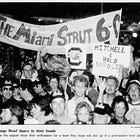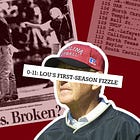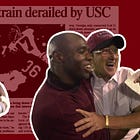8 takeaways from the historical SP+ data ESPN released this week
The godfather of advanced CFB stats has released a new resource that's going to make it a lot more fun to talk about the Gamecocks of yore.
Earlier this week, ESPN’s Bill Connelly released historical data on his advanced college football statistic, SP+,1 dating all the way back to 1883. I’ve been relying on Bill’s work for years to make myself sound smarter than I am, but until now the public-facing portion of his rankings has focused solely on the present or the relatively-recent past.
It would be hard to overstate what a big deal this is, especially for a newsletter like this one, which primarily concerns itself with distant past. One of the difficulties in writing about periods of South Carolina football that pre-date YouTube, VCRs, modern statistics, and even the concept of dedicating newspaper column inches to college football — is that information on historic teams is much harder to come by.
So it’s very difficult to compare teams that played in different eras. SP+ helps makes that easier by boiling a team’s quality down to a single number and placing it in context. I’m looking forward to spending more time getting lost in the weeds here, but for now I wanted to share some takeaways that leapt out at me looking at the historical data on USC.
First, though, I need to talk some business.
I’m excited to introduce a subscriber referral program that allows readers like you to make progress toward earning a free or discounted subscription when you share links to To Thee, Forever Ago stories with your friends.
How to participate
1. Share TTFA. When you use the referral link below, or the “Share” button on any post, you'll get credit for any new subscribers generated by your activity. Simply send the link in a text, email, or share it on social media with friends.
2. Earn benefits. When more friends use your referral link to subscribe (free or paid), you’ll receive special benefits.
Get a 1 month comp for 3 referrals
Get a 3 month comp for 5 referrals
Get a 6 month comp for 25 referrals
To learn more, check out Substack’s FAQ.
Now, back to SP+ …
1) The 2013 team was the best to ever do it
I’m not sure how much more additional commentary this point requires. It felt true at the time, and the historical SP+ data confirms it: 2013 was the height of the Steve Spurrier era, an era which was itself the height of the Gamecock football program.
The 2013 team had everything: a top-20 offense, a top-five defense, and a competent but unspectacular special teams unit. The only thing it lacked was an SEC East title.
If this season had taken place just one year later, the Gamecocks would have have been able to credibly make the now-familiar argument that they should make it into the CFB Playoff despite not making it to their own conference championship game.
Alternatively, if someone other than South Carolina could have done its job and defeated Mizzou during the last two months of the season, the Gamecocks would have been a tossup against Auburn in the SEC Championship Game.
2) The 1984 team was not that good
If the advanced stats are to be believed, the 1984 Gamecocks should not have been anywhere near the national title conversation, Navy loss or no Navy loss. SP+ ranks Joe Morrison’s most fabled squad at 30th in the country among its peers, dragged down by a defense that ranked 61st nationally.
It was a season defined by close scrapes and thrilling comebacks, but the underlying performances left something to be desired against a schedule that Sports Reference ranks 60th out of 110 teams. The Gamecocks only beat one team, FSU, that ended the season ranked in the top 25.
3) 1987 is our most underrated season
If 1984 is the most overrated South Carolina team, then the one that Joe Morrison produced three years later is the most underrated. Maybe it was the 2-2 start that quickly dashed any title aspirations, or maybe it was Todd Ellis’s 10:24 touchdown-to-interception ratio. Whatever the cause, this is not a season that looms especially large in the collective memory of USC fans.
But according to SP+, that appears to be a grave injustice.
The ‘87 Gamecocks are second behind the 2013 Gamecocks in their overall SP+ ranking (ninth nationally), and they were the most balanced across offense (13th) and defense (seventh) of any USC team. The defense’s turnaround from a 73rd-place finish the year prior was orchestrated by first-year coordinator Joe Lee Dunn, who’d come to Columbia from New Mexico four years after his once-and-future boss, Morrison, made the same move.
4) The 1986 squad produced our best-ever offense
It’s a shame the 1986 defense wasn’t better (the disparity between the 1986 offense and the 1986 defense was the fourth-largest in program history), as it meant the Gamecocks’ best offense of all time was effectively wasted on a 3-6-2 season. Todd Ellis’ freshman campaign was, far and away, his best season, and it was also the career highlight for junior wideout Sterling Sharpe.
A year later, a very similar group of offensive players produced USC’s second-best offense of all time.
This is a hard thing for me to say about our all-time leader in interceptions thrown, but … maybe Todd Ellis deserves more credit.
5) 1999 was the worst offense in living memory
South Carolina’s worst offensive season was 1939, but since no one reading this was alive to see that, let’s talk instead about the third-worst offense: 1999. As Shane Beamer’s team was struggling during the first two months of the 2021 season, I wrote that there is a tendency to understate how bad Lou Holtz’s first team was. As time has gone on, we’ve forgotten how uncompetitive the 1999 squad was, particularly on offense.
They were so bad, that the elder Holtz threw his offensive philosophy out the window and, while the 1999 season was still in progress, was making plans to turn over the reins to his spread-oriented son, Skip.
6) 2000 was USC’s best defense of all time
It’s easy to overlook just how big the offensive turnaround was in 2000 (112th to 70th) because it happened simultaneously with Charlie Strong improving his defense from 48th in 1999 to second in the whole dang country.
Of note: even with that 38-place improvement for Skip Holtz’s offense, this is still the sixth-biggest mismatch between offense and defense in program history. 2002 is the second-biggest mismatch, putting the Holtz era in some truly rarified air when it comes to great defense and terrible offense.
The next best defenses are, in order: 2011, 2012, and 2013. Right after that? Our old friend 1987.
7) South Carolina is Special Teams U
It is widely known that the Gamecocks won the special teams national title in 2022. What’s perhaps slightly less appreciated that we are living in a special teams golden age — one that predates even the arrival of Shane Beamer. In four of the past five seasons, USC has finished in the top 10 of the SP+ special teams rankings.
8) The 2022 team is among the best in program history
Most people agree that the 2000, 2005, and 2009 Gamecocks were pretty good. What’s weird to think about is that, according to SP+, the 2022 Gamecocks were better than every single one of them. USC’s final SP+ ranking last year, 19th, puts it dead-even with the 1980 team that went 8-4 and won George Rogers a Heisman Trophy.
I encourage you to spend some time digging through the Google Sheet Bill shared. I’d love to see what observations others come up with.
Bill has previously explained SP+ like this: “SP+ is a predictive, forward-facing measure of college football efficiency. It's presented as an adjusted points per game figure. For example, if a team's SP+ rating is plus-19.0, that means it's 19 points better than the average college football team … It's intended to be predictive and forward-facing. If a team is lucky or unimpressive in a win, its rating will probably fall. If a team is strong and unlucky in a loss, its rating will probably rise.”







i was surprised to see your characterization of the 2013 special teams because I remember writing a decade ago (oh God, how can that be) that the only thing preventing that team from being the best team in the country was special teams. Digging it up, it seems that was based on FEI, not SP.
https://www.garnetandblackattack.com/2014/1/8/5287584/gamecock-football-best-in-the-country
Wow spread sheet, that's information overload. You break it down very well.